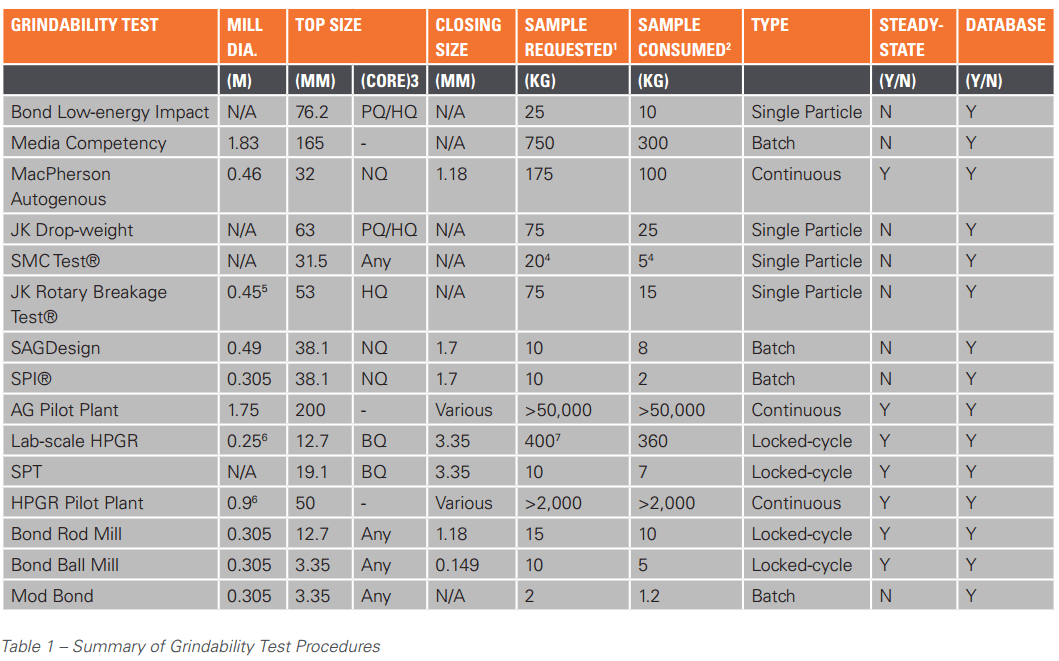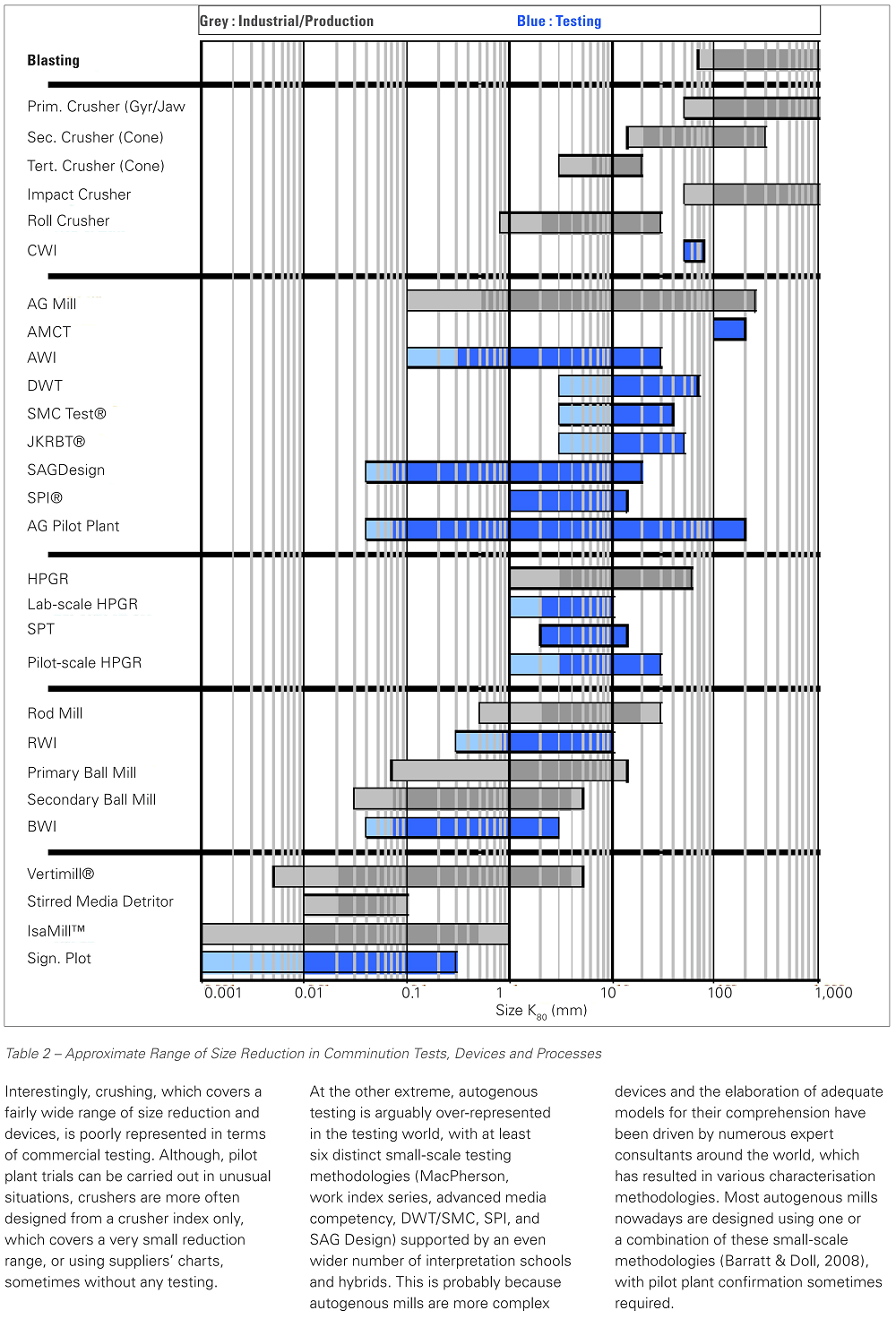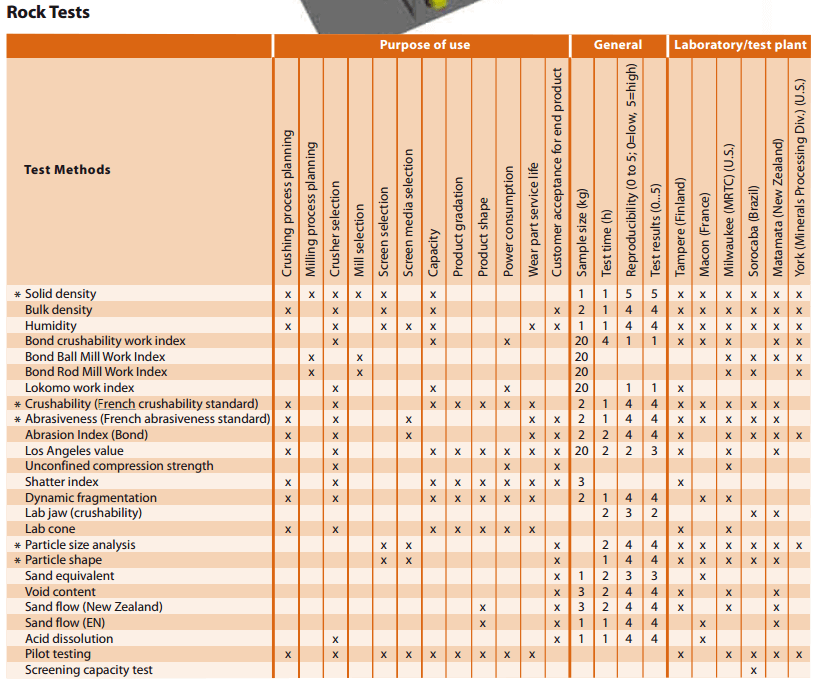Beginners might ask what grinding test data is required in order to properly size a grinding mill. After the grind requirements are established, testing for the selection of comminution circuits and mill size can be initiated and can include the following:
- Primary Autogenous Media Competency
- Primary Autogenous and Semi-Autogenous Pilot Plant
- Secondary Autogenous (Pebble) Testing
- Impact Crushing – Bond Work Index
- Rod Mill Grindability – Bond Work Index
- Ball Mill Grindability – Bond Work Index
- Abrasion Index
- Crushing, Grinding and Concentration Pilot Plant
SAG & AG Mills can be sized according to any of the most appropriate methods of rock hardness testing like SPI, JK, Barrett and Starkey.
This discussion will be limited to testing for selection of rod and ball mills. Rod and ball milling, using grinding media of known quality, are well established and require much simpler grinding test programs than required for the selection of autogenous grinding mills and circuits.
Samples for grindability tests should be crushed to about minus 1″.
The samples can be taken from adits, pits, trenches, etc., in the ore body or they can be crushed drill cores. While it is helpful in anticipating variations in feed rates to know the grindability of the various ore types in a deposit, for mill selection grindability tests should be run on composite samples representative of the blended mill feed. It is infrequent that the grindability of the composite or blend is the same as that obtained by mathematically making a proportional blend based on grindability tests performed on each component. Differential grinding occurs so that each component can be ground to a different size consist than the composite which has been ground to the required size.
Depending upon the size of the deposit, capacity of the concentrator, life of the operation, complexity of the ore deposit, complexity of the extraction or subsequent processes, etc., testing can range from one series of grindability tests to a large number of grindability tests and even possibly pilot plant testing. Often pilot plant testing is done primarily for metallurgical testing with grinding used for feed preparation.
Frequently pilot plants are built using available or used equipment with the grinding circuit oversize for the concentration section and as such the two are not balanced operations. Caution, therefore, should be used in selecting the test data to be used to select mills and circuits for the plant. The data should be selected from tests run specifically to obtain grinding data. This data should include:
- Size analysis and pulp density of:
- Feed rate to the circuit, dry basis,
- % moisture in mill
- Size analysis circuit feed.
- If cyclone classifiers: size, rated capacity, power draw and speed of cyclone feed pump.
- Size and type of classifiers.
- Any concentration steps in the grinding circuit.
- Type of circuit (open or closed) and flowsheet diagram.
- % volumetric loading in mill occupied by media.
- Mill Size
- Circuit product.
- Discharge from each mill.
- Feed to each classification stage.
- Oversize from each classification stage.
- Fines from each classification stage, k. Power drawn by each mill (motor input).
- Motor and drive efficiency of each mill,
- Size of and type of grinding media used in each mill.
- Speed in RPM for each mill.
- Liner design and condition in each mill.
- Media wear rate.
- Liner wear rate if tested long enough to obtain.
- % circulating load for each stage that is close circuited.
During grinding tests obtain samples of mill feed for grindability tests so that work indices calculated from the pilot plant data can be compared to grindability test results. Operating work indices can be obtained using pilot plant data in the following equation:
- Wio = Operating Work Index.
- W = Kwh per ton (can be metric, standard or long).
- P = Product size which 80% passes in micrometers.
- F = Feed size which 80% passes in micrometers.
The application of grinding circuit and equipment-related factors discussed later in this chapter are applied to Wio to put it on the same basis as grindability test results. This allows a direct comparison of pilot plant test results and grindability test results. In addition to these, also, be sure to apply motor and drive efficiency factors so that the pilot plant mill power data is referred to the mill pinionshaft or to the mill shell (measured power data is generally electrical energy into the motor). For comparison with grindability test results Wio has to be placed on the basis of standard tons (907.4 kg).
With the difficulty in obtaining accurate pilot plant data, particularly power data, Bond closed circuit grindability test results often give the more accurate data for selecting rod and ball mills. Grindability test work should span the feed and product sizes of the proposed grinding circuit. The grindability test work generally recommended for primary milling circuits includes:
With the difficulty in obtaining accurate pilot plant data, particularly power data, Bond closed circuit grindability test results often give the more accurate data for selecting rod and ball mills. Grindability test work should span the feed and product sizes of the proposed grinding circuit. The grindability test work generally recommended for primary milling circuits includes:
- Bond rod mill grindability tests at 10 or 14 mesh for Work Index.
- For each ball mill grinding step, a Bond ball mill grindability test for Work Index at one mesh size coarser than the desired 80% passing size and at the mesh size of or just finer than the 80% passing size.
- If 50 mm x 75 mm (2″ x 3″) ore lumps are available an impact crushing Work Index test.
- If 30 mm x 20 mm (1-1/4″ x 3/4″) ore is available an abrasion index test.
For regrind ball milling or ball milling of rougher concentrates produced in the grinding circuit run ball mill grindability tests as outlined in B above. Since the Bond grindability test requires a ratio of reduction of about 6:1 to obtain accurate results it may be necessary to run the test at a finer size than required by the specified grind or even a special test will have to be run.
This will give a good cross section of the grindability of the ore and will allow for accurate calculations of the grinding power required.
The balance of the discussion in the chapter will be an example demonstrating the selection of a primary grinding circuit and a regrind circuit where all of the ore is ground to the required product size in the primary circuit. For grinding circuits where concentration is included in the circuit the basic approach is the same as given in the example, considering each stage as a separate entity and adjusting for new feed rates and feed size (which could be different than the rate and product size from the preceding stage).
Rod Mills and Ball Mills: Chester Rowland Jr. and David Kjos. Allis-Chalmers



